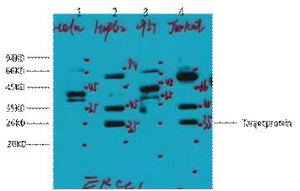XPA (Phospho Ser196) rabbit pAb
- Catalog No.:YP1722
- Applications:WB
- Reactivity:Human;Mouse;Rat
- Target:
- XPA
- Fields:
- >>Platinum drug resistance;>>Nucleotide excision repair
- Gene Name:
- XPA XPAC
- Protein Name:
- XPA (Phospho-Ser196)
- Human Gene Id:
- 7507
- Human Swiss Prot No:
- P23025
- Mouse Gene Id:
- 22590
- Mouse Swiss Prot No:
- Q64267
- Immunogen:
- Synthesized peptide derived from human XPA (Phospho-Ser196)
- Specificity:
- This antibody detects endogenous levels of XPA (Phospho-Ser196) at Human, Mouse,Rat
- Formulation:
- Liquid in PBS containing 50% glycerol, 0.5% BSA and 0.02% sodium azide.
- Source:
- Polyclonal, Rabbit,IgG
- Dilution:
- WB 1:500-2000
- Purification:
- The antibody was affinity-purified from rabbit serum by affinity-chromatography using specific immunogen.
- Concentration:
- 1 mg/ml
- Storage Stability:
- -15°C to -25°C/1 year(Do not lower than -25°C)
- Other Name:
- DNA repair protein complementing XP-A cells (Xeroderma pigmentosum group A-complementing protein)
- Molecular Weight(Da):
- 30kD
- Background:
- This gene encodes a zinc finger protein involved in DNA excision repair. The encoded protein is part of the NER (nucleotide excision repair) complext which is responsible for repair of UV radiation-induced photoproducts and DNA adducts induced by chemical carcinogens. Mutations in this gene are associated with xeroderma pigmentosum complementation group A. Alternatively spliced transcript variants have been found for this gene. [provided by RefSeq, Mar 2009],
- Function:
- disease:Defects in XPA are a cause of xeroderma pigmentosum complementation group A (XP-A) [MIM:278700]; also known as xeroderma pigmentosum type 1 (XP1). XP-A is a rare human autosomal recessive disease characterized by solar sensitivity, high predisposition for developing cancers on areas exposed to sunlight and, in some cases, neurological abnormalities. Group A patients show the most severe skin symptoms and progressive neurological disorders.,function:Involved in DNA excision repair. Initiates repair by binding to damaged sites with various affinities, depending on the photoproduct and the transcriptional state of the region. Required for UV-induced CHK1 phosphorylation and the recruitment of CEP164 to cyclobutane pyrimidine dimmers (CPD), sites of DNA damage after UV irradiation.,PTM:Phosphorylated upon DNA damage, probably by ATM or ATR.,similarity:Belongs to the XPA family.,subun
- Subcellular Location:
- Nucleus .
- Expression:
- Expressed in various cell lines and in skin fibroblasts.
- June 19-2018
- WESTERN IMMUNOBLOTTING PROTOCOL
- June 19-2018
- IMMUNOHISTOCHEMISTRY-PARAFFIN PROTOCOL
- June 19-2018
- IMMUNOFLUORESCENCE PROTOCOL
- September 08-2020
- FLOW-CYTOMEYRT-PROTOCOL
- May 20-2022
- Cell-Based ELISA│解您多样本WB检测之困扰
- July 13-2018
- CELL-BASED-ELISA-PROTOCOL-FOR-ACETYL-PROTEIN
- July 13-2018
- CELL-BASED-ELISA-PROTOCOL-FOR-PHOSPHO-PROTEIN
- July 13-2018
- Antibody-FAQs
- Products Images

- Western Blot analysis of 1 Hela cell, 2 Serum-free treated ,using primary antibody at 1:1000 dilution. Secondary antibody(catalog#:RS23920) was diluted at 1:10000



